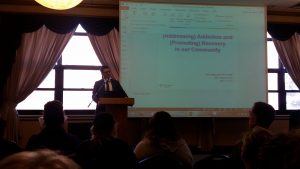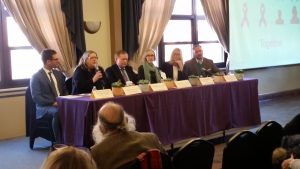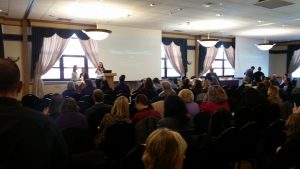WESTFIELD—Westfield State University (WSU) hosted opioid addiction experts as part of their guest lecture series yesterday, promoting the idea of “many paths to recovery.”
WSU welcomed, among other experts, Dr. Robert Roose, vice president of Mercy Behavioral Health at Sisters of Providence Health Systems and member of the Massachusetts Governor’s Opioid Addiction Working Group, as the keynote speaker for the event “Addiction and Recovery in Our Community: Many Paths to Recovery.” Roose provided a speech, as well as research regarding the trends in opiate use and treatment, followed by a panel discussion with his fellow experts and a naloxone demonstration, the medication that is used to reverse opioids’ effects on the body.
Roose’s comments focused on a number of facets within the opiate crisis that has impacted the region and country for the past several years. Within his comments, he showed that the area is still embroiled in the crisis, calling the western Massachusetts region “ground zero” for it.

Dr. Robert Roose addresses the crowd at WSU Wednesday morning, during the “Addiction and Recovery in Our Community; Many Paths to Recovery” event
“We still live very much in a nation, in a Commonwealth and in a community where substance abuse is still prevalent,” Roose said to the crowd.
“No mistaking it, we’re still very much in an opiate addiction crisis,” he added.
According to Roose, “nearly 2,000 people” are estimated to have died due to opiate overdoses in 2016, which is nearly double the amount from three years prior. Additionally, Roose said that a majority of the victims in those deaths were under the age of 44.
However, Roose also noted that lawmakers and practitioners are attempting to take the steps necessary toward improving the situation.
“Over the past few years support has been there from several agencies,” he said. This has included the US Surgeon General, who published a report on addiction in 2016, the first of its kind for that federal office.
In Massachusetts, former Gov. Deval Patrick previously made the opiate epidemic a “state of emergency,” and current Gov. Charlie Baker made the crisis a top priority for his administration, Roose said. In addition, Roose said from 2015 to now, more than $300 million in funds have been allocated by lawmakers to address the problem in Massachusetts, and in each of the last five fiscal years spending has increased.
The results thus far have been promising in some ways.
Roose noted that there has been an overall reduction in opiate prescriptions being offered, which is not “a sure tactic” to curb use, but it lowers the amount of unnecessary opiates in the community. Another correlation is the use of naloxone has increased on patients by emergency medical personnel.
Also, there has been an increase in inpatient treatment beds—the lack of which has been a significant roadblock for those seeking treatment—as well as improved insurance coverage of the services.
Still, the problems have gotten worse in some cases.
Roose said that fentanyl, a synthetic opioid pain medication that is significantly stronger than morphine, has had a “dramatic rise” in “post-mortem blood toxicology reports” of those who died of overdoses. Additionally, the crisis “involves multiple substances,” which includes cocaine and a class of medications known as benzodiazepines. Benzodiazepines, or “benzos,” are a class of psychoactive drugs which can be used for treatment of acute anxiety, insomnia, seizures and muscle spasms, but also can be a drug of abuse, and possible overdose symptoms that include respiratory depression, low blood pressure, coma and cardiac arrest.
In particular, Roose said that over half of those who died of opiate overdoses from 2014 to 2016 had benzodiazepines in their blood system.
“There have been results but overdose numbers have still gotten worse,” Roose said. “We need to come up with more data to see trends and revise plans.”
To combat this, Roose suggests that “we break down barriers to care,” which included:
- Focusing on prevention
- Expanding and enhancing treatment
- Support people in recovery
- Fight stigma

The panel of experts at WSU Tuesday morning. From left to right: Dr. Robert Roose; Judith MacMunn, LICSW; Dr. Stephen Ryzewicz; Susan Molano, LICSW; Alissa Burke, detective for West Springfield Police Department; Stephen Lee, DBH, PA-C
After Roose was finished, a panel discussion occurred, which included Roose, as well as Alissa Burke, detective for the West Springfield Police Department; Stephen Lee, DBH, PA-C, Physician Assistant program, WSU; Judith MacMunn, LICSW, Area Clinical Manager, Department of Children & Families; Susan Molano, LICSW, Substance Use Disorder Program, VA Central Western Massachusetts Healthcare System; and Dr. Stephen Ryzewicz, hospitalist, Baystate Medical Center.
The discussion focused mostly on barriers in place, both for those who try to help and those who need it. This included the topic of lack of space for those seeking treatment in residential programs, where an elongated stay at a facility occurs.
“We can’t get people into treatment facilities,” Burke said.
“The demand for treatment is greater than the capacity,” Roose added.
“There are wait lists for residential facilities, and even a few weeks can be too long,” Molano said.
Another barrier noted by the panel included the views from those involved, whether it is the provider or the family. Burke suggested that parents should get involved in the process of recovery, while Lee said that attitudes from everyone, including providers, need to change to help the process.
To wrap up with the event, a pharmacy intern from Western New England University, Brianna Guite, provided those in attendance with a demonstration on naloxone. Guite explained how naloxone works, which is by “competing” with the opiate receptors in the brain that opioids also latch to, thus temporarily blocking the opiate’s ability to produce their effects.
To administer, Guite displayed two common forms that people can get from pharmacies without a prescription, both of which are through the nasal passages. Both techniques require simple assembly of a device to the medication and a squeeze with the forefinger and middle finger on top and the thumb on the bottom.


